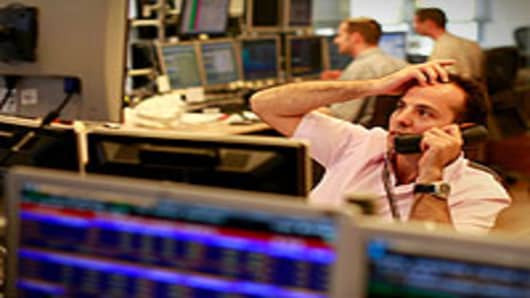A third round of quantitative easing (QE3) in the United States is still far from a foregone conclusion, with traders and investors divided as to its likelihood and the effect it might have, if enacted.
Bill Gross, founder of investment manager Pimco, made a bullish call on Twitter Wednesday after a surprisingly dovish set of minutes from the Federal Reserve’s Open Market Committee (FOMC). “Fed minutes make QE3 and extended period language an 80 percent probability. Front-end curve friendly,” he wrote.
European shareswere buoyed on Thursday while Asian shares rose to a two-week high on hopes that a third round of mass liquidity injections (CNBC Explains: What is Quantitative Easing?) could be announced as early as Fed Chairman Ben Bernanke’s speech at Jackson Hole next week.
The dollar fellagainst a basket of currencies and the euro rallied to above 1.2550 against the greenback. But the market moves could end up being presumptuous.
“I’m not sure that QE3 is hard upon us. From my reading of the minutes, I think it is being debated and discussed but the Fed is also looking at other ways of getting more monetary stimulus directly to the consumer,” Dennis Gartman, author of The Gartman Letter, told CNBC Europe’s “Squawk Box” Thursday. (Click to watch)
“I don’t think it’s been put off the table, but I don’t think they have their knives and forks ready to start digesting it yet. The Fed (CNBC Explains: What Is the Federal Reserve?) won’t want to take monetary action in the months ahead of the election, in case it looks political.”
The minutes also pointed to the potential for other forms of easing like extending the existing commitment to historically low interest rates.
Nick Beecroft, U.K. chairman and senior market analyst at Saxo Bank, warned of a “head fake” by the Fed minutes and argued that there is a 50-50 chance of Bernanke announcing QE3 next year.
“The market seems incredibly complacent given the number of tripwires over the next few weeks,” he told CNBC.
He recommended going back into safe havens, but not German bunds, as he argued that worries about Germany’s exposure to the rest of the euro zone will harm them.
The yen strengthened against the dollar following the news, but Derek Halpenny, European head of global markets research, Bank of Tokyo-Mitsubishi UFJ, argued that this would not continue.
“We do not expect a further substantial move lower in USD/JPY,” he wrote in a research note. “We don’t see grounds for any notable sustained dollar sell-off and stronger economic data would quickly place doubts on QE3 at the 13th September [Fed] meeting.
Gold could recover some of its recent losses following the minutes, Gartman argued.
He expressed concern that this set of minutes “merely sent stock prices bouncing from the lows” rather than leading to a stronger rally.




